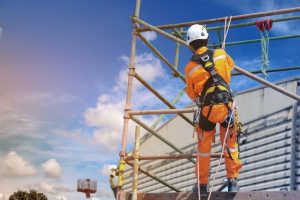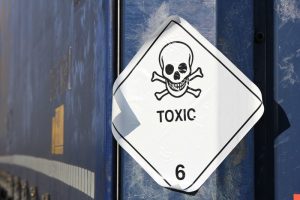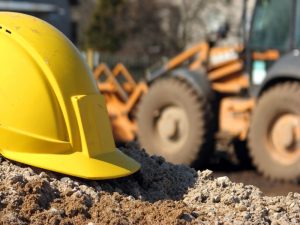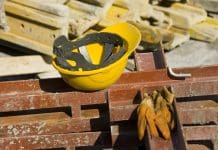In the UK, the construction industry is considered the most dangerous. Medtree, leading medical suppliers for first aid and other essential apparatus, share the provisions you must put in place on your construction sites
The recent government reports for 2017 have only strengthened this opinion, with the highest number of non-fatal and fatal injuries attributed to construction. Health and safety is of paramount importance in the industry, with an average of 64,000 injuries reported in 2017 alone. Of those 64,000, 49% are said to be due to falls.
Your duty of care is not only to your employees, but all external contractors and visitors to the site. As such, you need to undertake a risk assessment, as outlined in the Health and Safety at Work Act 1974.
Risk Assessments
Risk assessments are a government requirement and should work to reduce potential risks for your staff. The assessment should highlight any unsafe equipment or conditions, and you can find templates online if you’re unsure what to include. You must assess:
- Emergency provisions to resolve incidents
- Identify first aiders on your construction site (ensure they have met the proper training)
- If any equipment or unsafe conditions have been identified, work to resolve and reassess at a later date.
It’s more than likely your construction site will have hazardous equipment and conditions – it’s the nature of the industry. However, by informing all staff of hazards and working to reduce risks as much as possible, you can safeguard your staff and, subsequently, your business reputation.
Hazards on construction sites
The potential for accidents is significantly higher in construction than any other industry, particularly with dangerous tools, surfaces and the like. In some cases, even toxic substances. You cannot erase the possibility of all accidents, but identifying the most common causes will help with the longevity of your business.
Fall incidents
As mentioned above, falls account for the largest number of accidents within the industry. The reasons are in high numbers, with incidents reported due to unsteady work surfaces, lack of essential equipment (harnesses etc.), no protection and even mistakes down to human error. For sites with staff working above six foot, with unprotected sides, you must:
- Install guardrails
- Ensure proper safety net systems
- Install aerial lifts
- Have elevated platforms
- Cover floor holes etc.
 Scaffolding
Scaffolding
Scaffolding is highly-dangerous and, similar to that of falls, accounts for a substantial number of injuries. In 2017, the number of staff working on scaffolding projects hit a huge 2.3 million, with a recorded 60 fatalities annually due to installing and working on unsafe scaffolding. If your site does require a scaffold, the apparatus must always be erected by fully qualified companies. The scaffolding design must include:
- Solid footing and planked
- Erected over 10 feet from the nearest power line
- Include guardrails, midrails and toeboards for staff
- Head protection for all employees
- Your company must provide non-skid work boots
- Make sure max load is never exceeded.
In February 2018, a scaffolder was charged for working 60 feet in the air, without a harness. He was sentenced to 100 hours community service, highlighting the potential penalties for not ensuring the safety of employees.
Stairways and ladders
Fall injuries can also be attributed to poor stairways and ladder installations – especially with unsafe ladder equipment. If you do not implement secure ladders and stairways, your staff face potentially dangerous conditions, which can leave your business extremely vulnerable. They may not be able to complete their tasks, or carry necessary tools and equipment. To reduce the risk of incident, you should:
- Tag or mark all ladders that have failed to meet standards
- Ensure all staff receive thorough training on ladder safety
- Provide employees with tool belts and rope to safely carry essential materials.
 Toxic substances
Toxic substances
It’s likely that a large number of construction sites will deal with the handling, and work, with toxic substances. We all understand the risks of exposure to toxic substances – chemical burns and further long-term injuries – but there is also a significant increase in the chance of fire and explosions. You can put measures in place, including:
- Maintain your Material Data Safety Sheet (MSDS)
- List all onsite chemicals and ensure the list is easily accessible
- Provide guidance on reading the MSDS
- Always follow the manufacturer’s handling guidelines for toxic substances
- Provide information on first aid, with all first aiders named
- Keep all chemicals stored in a safe place.
Electrics
The risk of electric shock is one that cannot be underestimated, especially for those working with overhead lines, cable harnesses and circuit assemblies etc. If your site deals with electrical components, you must:
- Identify and clearly highlight all live, energized circuits
- Provide all employees with personal protective equipment
- Install guardrails on high surfaces to avoid falls
- Clear debris from the area and regularly maintain
- Shield welding areas
- Put in place the relevant fire extinguishers
- Never let temporary electrics overload.
Personal safety checklists
While you must certainly identify and resolve (if possible) unsafe working conditions and equipment, you also have a duty to provide the proper protection to employees. They should always meet government standards, which can be found online, to reduce the risk of injury. Without proper equipment, you are opening your business to huge legal claims should an employee suffer an accident.
Face protection
Protection for the face needs to be worn at all times when working with hazardous equipment, and there are absolutely no exceptions. Foreign objects entering eyes can cause lasting damage, especially when conducting jobs including welding, cutting and grinding.
 Head protection
Head protection
Similar to face protection, head protection is essential. You must provide all staff with hardhats, along with any visitors to your construction site. The functionality of the hardhats is also crucial, with regular checks in place for any dents, cracks or damage.
Hand and foot protection
There are rules in place for wearing gloves on construction sites, with all gloves required to fit the employee’s hands entirely. Likewise, there should be routine inspections of the gloves – especially for heavy-duty gloves. Work boots should also be anti-slip, anti-puncture and with steel caps to avoid crushed toes.
First aid kits
There should always be more than one first aid kit onsite, with the number dependent on the size of your company. A basic first aid kit should feature:
- Gloves
- Various types of dressing
- Eye pads
- Sharp and blunt scissors
- Instant ice packs
- Triangular bandages
- Sterile gauze swabs
- Crepe bandages
- Wound wash solution
- Deep freeze spray
- Emergency foil blanket
- Safety pins
- Resuscitation face mask.
Creating an emergency action plan
Your emergency action plan should include provisions if an incident occurs. We’ve put together nine steps, using the above info so that you can get started.
- As management, your responsibility is to plan and implement the procedure and regularly review it to ensure it is still suitable.
- Keep all health and safety procedures up-to-date, and following the government requirements.
- Provide staff with extensive first aid training, and give all employees information on the first aiders.
- Keep the first aid certificates within date and an easily accessible place.
- Offer detailed handouts on the conditions and equipment that may be dangerous, with your provisions in place.
- Outline the importance of accident reporting immediately after an incident, and share the forms that staff must fill out in case of emergency.
- Check stock regularly for the first aid kits.
- Ensure you have a fall protection system in place at your construction site.
- Create accountability at all levels and make sure all staff understand their responsibilities.
Sources:
http://www.hse.gov.uk/statistics/industry/construction/
https://www.constructconnect.com/blog/construction-safety/10-construction-site-safety-tips/
https://www.osha.gov/SLTC/scaffolding/construction.html
http://www.hse.gov.uk/construction/cdm/2015/index.htm
http://www.hse.gov.uk/legislation/hswa.htm
Medtree
Twitter:@medtreeuk










![[VIDEO]What to expect when you’re inspecting: Using DorTrak for fire door inspections](https://www.pbctoday.co.uk/news/wp-content/uploads/2025/02/maxresdefault-218x150.jpg)


